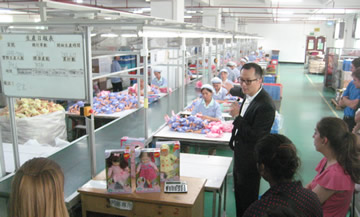A Toy’s Story
As you wander the aisles at Target, looking for a baby doll for your favorite niece’s birthday or a new pair of jeans, do you ever stop and consider how all of that merchandise got there? Sure, trucks loaded with boxes probably arrive day and night, but where do they come from?
This story first appeared on Know.
Understanding and mastering that journey is the heart of supply chain management.
Students in Michael Hasler’s introductory operations management class have spent five weeks each summer since 2010 looking into this everyday marvel. But rather than merely sitting in lectures and reading case studies, these business majors track products—a doll, a calculator, blue jeans, melamine dishware—upstream through the supply chain, starting at an Austin Target store and ending up in factories located throughout the Pearl River Delta region in southern China.
The class is more than just an extended field trip, though. “Relating to an experience is key to adult learning,” says Hasler. “Everyone has been to a Target, but this forces you to look at the whole operation in a new way.”
The seed idea for the course was planted in 2005, when the university’s Center for International Business Education and Research began working with faculty members in supply chain management — which wasn’t even a major at that point — to develop a core course that students could take abroad.
Fast forward to May 2009. Hasler and a group of McCombs School of Business colleagues met with supply chain executives at Target’s Minneapolis headquarters. The Target team brought out a map that illustrated the international nature of the company’s supply chain, with stops from a distribution center in north Texas all the way to manufacturing plants in China.
“We realized there might be an opportunity here to do something more special than the usual academic-industry partnership,” recalls Doug Houseman, senior project manager in Target’s distributed automation group and Hasler’s partner in developing the course.
Three years later, the supply chain management major has nearly 170 students, and Hasler’s course is collecting accolades. He won the 2012 Wickham Skinner Teaching Innovation Award from the Production and Operations Management Society in April, an international honor, and he also picked up the McCombs School 2012 Teaching Innovation Award in May.
“Turns out the course is a pretty big innovation,” says Hasler.
The 2012 Student Travelogue through the Target Supply Chain
The class began May 16 with a visit to an Austin Target store, where students found the finished products they would follow back to their origins in Chinese factories. They were also introduced to some key supply chain concepts in action, such as replenishment of floor stock, number of employees staffing the checkout lanes, and different inventory models.
“I recently started my Supply Chain Management Program and I have to say, it is a pretty amazing experience so far and we just got started. My brain is exploding with information and I cannot wait to put it to use,” blogged junior Mukthi Dasaraju, a supply chain major.
Midlothian, Texas
 The next day the group headed north to the Target Regional Distribution Center in Midlothian, Texas, near Fort Worth — an immense, 1.35-million-square-foot building with a maze of conveyor belts moving thousands of boxes each day.
The next day the group headed north to the Target Regional Distribution Center in Midlothian, Texas, near Fort Worth — an immense, 1.35-million-square-foot building with a maze of conveyor belts moving thousands of boxes each day.
The Target team discussed the roles of consolidators and deconsolidators, productivity improvement efforts, complexities in handling products of different sizes, values and sales cycles, and managing people in a dynamic warehouse environment.
“Imagine the size of 22 football fields…that’s how big the Distribution Center (DC) is! Within the DC, there are 7.5 miles of conveyor belt! Target definitely knows how to get their products through the DC efficiently!” wrote junior Samantha Kherkher.
Port of Long Beach, California
In early June, the class flew to Los Angeles for a day of class and a tour of the Port of Long Beach, Calif., where they saw firsthand the unloading and sorting of thousands of containers filled with goods destined for stores such as Target.
“It was neat to actually get to see a container ship up close with thousands of shipping containers being unloaded for distribution and shipment to all around the continental United States,” wrote David Liu, BBA ’12, on the blog he kept about the trip in 2010. “This really helped to put a perspective on where many goods that are made in China/Asia … first enter the United States.”
The students generated process maps of this activity to help them calculate capacities and identify bottlenecks. A few weeks later, the students compared their Long Beach process maps to new ones they created to capture the workings of the Port of Yantian in Shenzhen, China, the point of origin for many goods shipped to the U.S. from China.
Dasaraju was equally enthusiastic in her post about the California visit. “The port at Long Beach was amazing! The ships were massive and it’s crazy to think how they travel safely in rough waters half way across the world.”
Hong Kong, China
After a long day of travel across the Pacific Ocean, the students settled into their dorms at the Chinese University of Hong Kong, their headquarters for the next five weeks of classes. Hasler, a lecturer in the Department of Information, Risk and Operations Management at McCombs, developed his business cases based on factory visits and experiences the class has had in prior years.
 “They read about a doll factory and how its operations work one week, then visit that very factory the next week,” Hasler says. “It makes for immediate connections.”
“They read about a doll factory and how its operations work one week, then visit that very factory the next week,” Hasler says. “It makes for immediate connections.”
“This class has been my introduction to the world of operations and production. There’s a science behind production and service,” wrote Jared Pelley, BBA ’12, about his experience during summer 2010. “Yesterday, we learned a mathematical formula to tell you how long people will wait in line for something!” Today, Pelley is an analyst in PricewaterhouseCoopers’ supply chain consulting practice.
The first stop in mainland China was Hong Kong City Toys, a doll factory. Students observed the entire process from raw material to final packaging.
“We didn’t have to spend time trying to visualize and understand the processes because we were seeing them in real time,” said Eva Agoulnik, BBA ’12, who took the course in 2010.
A standout moment for Hasler was in 2010 when the general manager of Hong Kong City Toys said his most significant challenge was “identifying and resolving his bottlenecks.” At that, the students whipped their heads around and grinned at Hasler, who was observing from the back of the room.
“We had just finished reading and discussing The Goal, which focuses on how to identify bottlenecks and manage systems, and we had already seen the other links in the distribution chain,” Hasler explains. “The students realized what they were learning in class really did apply to supply chain in the field. I saw 20 light bulbs go off—it’s one of the absolute highlights of my teaching career.”
After stops at other factories, students returned to the final two weeks of class in Hong Kong with a deeper understanding of the supply chain as they learned about applying different inventory models to the appropriate situations.
Seeing the supply chain process in action not only improves understanding for the students, it results in better grades. The average grade on Hasler’s final exam for the course this summer was a 92—10 to 14 points higher than the average for classes that didn’t have the hands-on experience. And Hasler reports that since 2010, several students decided to change or declare their major to supply chain management after taking the course.
“It makes a huge difference in how they pick up the concepts,” Hasler says. “It brings ideas to life.”
Photos from top: Students tour a factory in Hong Kong (Michael Hasler); Target carts (courtesy David Smith on Flickr); at the Target Regional Distribution Center in Midlothian, Texas (Mukthi Dasaraju); at a doll factory in Hong Kong (Michael Hasler).


















No comments
Be the first one to leave a comment.